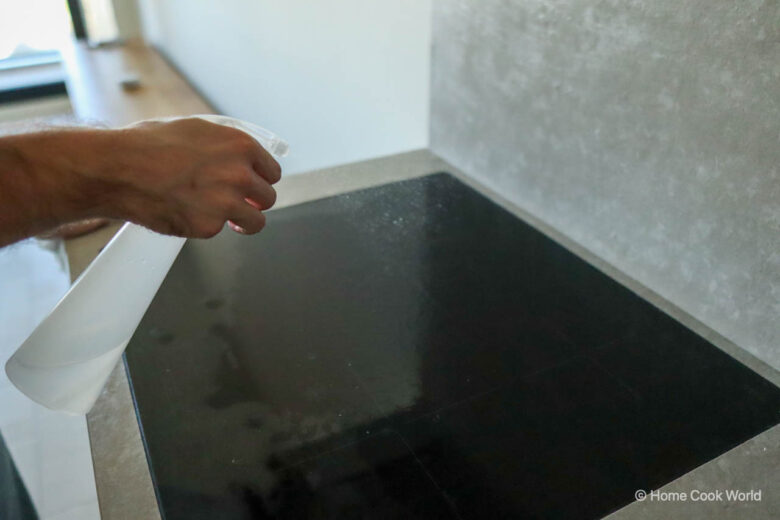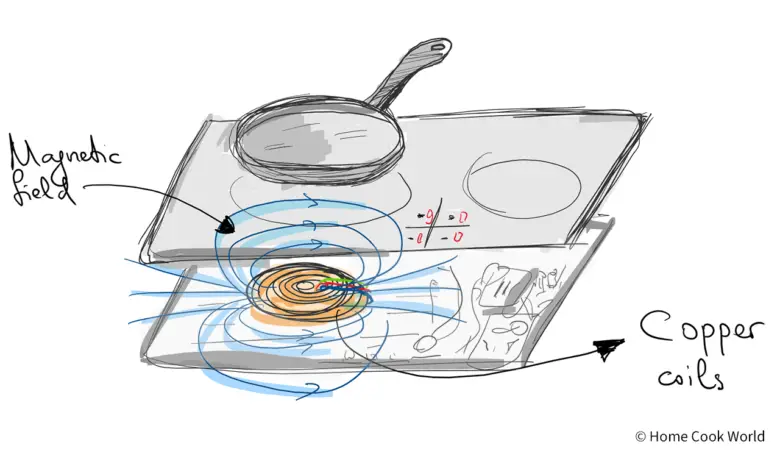It’s been half a year since I started cooking with induction. So far, it’s been working out great. Enough so that I continue to stick to the opinion that, despite their higher price, induction cooktops are generally worth it.
The cooktop heats my pans and pots quickly and evenly (for those of you coming here for the first time and who may be wondering, I cook mostly with tri-ply stainless steel and every now and then with cast iron).
Since my induction cooktop’s surface stays cool and my cookware heats from the inside out (I’ll tell you exactly how this works later on in this post), cleanup has been mostly effortless.
How Easy Is It to Clean an Induction Cooktop?
Even a couple of times when I had filled my pot with way too much water—and it ended up spilling out, all I had to do was lift the pot, wipe the bottom of it and the cooktop’s surface with a kitchen towel, and continue cooking.
Simply said, an induction cooktop is a convenient appliance for the home cook who’s keen on cooking every day but just as lazy to clean up after themselves. (Did I hit this one on the nail or what?)
As I was looking for the best cleaner kits online, I noticed that most of them had pretty aggressive formulas. “Keep out of reach for children and pets,” “avoid contact with eyes,” “do not swallow.” Some went as far as to recommend using rubber gloves to protect your skin from burns.
The thing is that most of these cleaner kits are made for radiant cooktops, which heat your pans and pots indirectly by heating electric burners under the surface.
Since the surface of radiant and induction cooktops is made of glass-ceramic, it’s easy for brands to promote cleaner kits created for radiant cooktops as the best solution for cleaning induction.
There are also specialized cleaner kits for induction cooktops. No matter how trustworthy the brand or how convincing the messaging on the front of the label, somehow I couldn’t justify their steep price.
So I thought to myself… What’s a more natural (and less costly) way to clean my induction cooktop?
As you can expect from any post on Home Cook World, I’ve been reading about and trying out many natural cleaning methods over the past few weeks so that you don’t have to.
Cleaning Your Induction Cooktop With White Vinegar


If you want a more natural and less expensive cleaning solution for your induction cooktop, you can substitute the chemically aggressive and costly cleaner kits with a cloth dabbed in distilled white vinegar. Alternatively, you can use apple cider vinegar (as I’m doing in the photos).
Clean your induction cooktop by dabbing a lint-free cloth or paper towel with distilled white vinegar and wiping the glass-ceramic surface thoroughly with it. Remove stubborn stains by rubbing more thoroughly.
Distilled white vinegar costs as little as $0.02/fl oz and has been proven to kill some of the most common germs and bacteria in the kitchen, such as E.coli and Salmonella.
The distilled white vinegar bottles sold at the grocery store are typically a solution of 5% acetic acid and 95% water. This concentration makes the vinegar gentle enough not to damage your cooktop’s glass-ceramic surface—yet powerful enough to dissolve fats and kill germs.
Some bloggers out there will tell you also to use baking powder. But if you ask me, this can do more harm than good. First, you’ll need to clean up after the cleanup (which kind of defies the purpose). Second, you could scratch your cooktop if you’re not careful.
In my experience, vinegar is powerful enough as a household cleaner not to need any “helpers.” You can even clean white stains from your induction cooktop if you cook with wet pans and pots and have heavy water in your home (the spots come from calcium and magnesium residue in the water).
Cleaning Your Induction Cooktop With Rubbing Alcohol


Those of you looking for a more natural alternative to store-bought cooktop cleaner kits can substitute them with rubbing alcohol.
Spray rubbing alcohol with a concentration of 70% on your cooktop, and wipe it dry using a paper towel. Since alcohol breaks down fat and sanitizes surfaces, your cooktop will come out shiny and clean.
Since 90% alcohol evaporates too quickly, 70% alcohol is the better choice for cleaning and disinfecting surfaces. Generally speaking, any alcohol with a higher or lower concentration than 70% is considered to be a less effective cleaner and disinfectant.
On average, ethanol and isopropyl alcohol cost $0.25/fl oz. Although more expensive than distilled white vinegar, alcohol is better at sanitization.
How Induction Cooktops Work
Unlike their gas or electric counterparts, induction cooktops don’t have gas burners or electric heating elements. The surface, made of highly resilient glass-ceramic, stays cool as the cookware heats by itself.
Don’t know how induction cooktops work? Here’s the rundown.
Under each zone is a copper coil. When you turn a zone on, the cooktop runs an alternating electric current (AC) through the coil. This creates an electromagnetic energy field, which passes through the glass-ceramic surface and goes straight to your pan or pot.
As long as your pan or pot contains enough iron, that energy will cause the iron molecules in it to vibrate tens of thousands of times per second. The iron molecules’ movement creates friction, which in turn creates heat directly inside the cookware.

This is also why induction cooktops make noise, especially when you cook with induction-friendly non-stick or clad stainless steel. These types of cookware are typically made of multiple layers of steel, clad around a thick and heavy base. The noise comes from the forces between the individual layers.
In Conclusion
So you don’t need cleaner kits to keep your cooktop shiny and spotless. You can use distilled white vinegar (the cheapest option) or 70% alcohol (best at sanitization) instead.
Since I found out about this and tested it, I’ve stuck to it and haven’t gone back. Try it out for yourselves, and you won’t be sorry that you did.
What to Read Next
Liked this article? Here are some ideas for what to read next.
Check out what chefs think about induction cooking. Induction is as new as cooking technology gets. It’s interesting to see that some of the pros are already swearing by it, while others are sticking to their gas stoves. Head on over to that article to learn why.

